
Jefferies Consumer Finance Summit December 2020

Disclaimer 2 IMPORTANT: You must read the following information before continuing to the rest of the presentation, which is being provided to you for informational purposes only. Forward-Looking Statements This presentation contains forward-looking statements. These forward-looking statements include assumptions about size of addressable markets; financial performance of our Canadian business for the remainder of 2020 and 2021; growth opportunities across our business, including earnings growth through our relationship with Stride Bank and the timing of the expected expansion of the product; customer demand trends; opportunities created by a changing competitive landscape; impacts of COVID-19 resurgence and level of customer assistance requests, opportunities from ancillary card products and Katapult; our outlook for fourth quarter performance, including AR growth, NCO rates, AEBITDA and contributions from Katapult; the resiliency of our business model, funding sources, liquidity and leverage; and our belief that we are well positioned to manage through COVID-19 and to grow after the crisis abates. In addition, words such as “guidance,” “estimate,” “anticipate,” “believe,” “forecast,” “step,” “plan,” “predict,” “focused,” “project,” “is likely,” “expect,” “intend,” “should,” “will,” “confident,” variations of such words and similar expressions are intended to identify forward-looking statements. Our ability to achieve these forward-looking statements is based on certain assumptions and judgments, including the effects on our business of COVID-19, its impact on our ability to continue to service our customers, our revenue and overall financial performance and the manner in which we are able to conduct our operations, increases in charge-offs in light of the impact of COVID-19, our ability to execute on our business strategy and our ability to accurately predict our future financial results. These assumptions and judgments may prove to be inaccurate in the future. These forward-looking statements are not guarantees of future performance and involve known and unknown risks and uncertainties that are difficult to predict with regard to timing, extent, likelihood and degree of occurrence. There are important factors both within and outside of our control that could cause our actual results to differ materially from those in the forward-looking statements. These factors include the impact of COVID-19 on the macro-economic environment and how that may impact our customers and other parties with whom we do business, our dependence on third-party lenders to provide the cash we need to fund our loans and our ability to affordably access third-party financing; errors in our internal forecasts; our level of indebtedness; our ability to integrate acquired businesses; our dependence on third-party lenders to provide the cash we need to fund our loans and our ability to affordably access third-party financing; actions of regulators and the negative impact of those actions on our business; our ability to protect our proprietary technology and analytics and keep up with that of our competitors; disruption of our information technology systems that adversely affect our business operations; ineffective pricing of the credit risk of our prospective or existing customers; inaccurate information supplied by customers or third parties could lead to errors in judging customers’ qualifications to receive loans; improper disclosure of customer personal data; failure of third parties who provide products, services or support to us; any failure of third-party lenders upon whom we rely to conduct business in certain states; disruption to our relationships with banks and other third-party electronic payment solutions providers; disruption caused by employee or third-party theft and errors in our stores as well as other factors discussed in our filings with the Securities and Exchange Commission. Given these risks and uncertainties, investors should not place undue reliance on forward-looking statements as a prediction of actual future results. We undertake no obligation to provide guidance for future periods as is included in this presentation and no obligation to update, amend or clarify any forward-looking statement for any reason. Non-GAAP Financial Measures In addition to the financial information prepared in conformity with U.S. GAAP, we provide in this presentation certain “non-GAAP financial measures,” including: Adjusted Net Income (Net Income from continuing operations minus certain non-cash and other adjusting items); Adjusted Earnings Per Share (Adjusted net income divided by diluted weighted average shares outstanding); Adjusted EBITDA (EBITDA plus or minus certain non-cash and other adjusting items); Gross Combined Loans Receivable (includes loans originated by third-party lenders through CSO programs which are not included in our consolidated financial statements); and Adjusted Return on Average Assets. Such measures are intended as a supplemental measure of the Company’s performance that are not required by, or presented in accordance with, GAAP. The Company presents Adjusted Net Income, Adjusted Earnings Per Share, Adjusted EBITDA, Gross Combined Loans Receivable and Adjusted Return on Average Assets because it believes that, when viewed with the Company’s GAAP results and the accompanying reconciliation, such measures provide useful information for comparing the Company’s performance over various reporting periods as they remove from the Company’s operating results the impact of items that the Company believes do not reflect its core operating performance. Adjusted Net Income, Adjusted Earnings Per Share, Adjusted EBITDA, Gross Combined Loans Receivable and Adjusted Return on Average Assets are not substitutes for net earnings, cash flows provided by operating activities or any other measure prescribed by GAAP. There are limitations to using non-GAAP measures such as Adjusted Net Income, Adjusted Earnings Per Share, Adjusted EBITDA, Gross Combined Loans Receivable and Adjusted Return on Average Assets. Although the Company believes that Adjusted Net Income, Adjusted Earnings Per Share, Adjusted EBITDA, Gross Combined Loans Receivable and Adjusted Return on Average Assets can make an evaluation of its operating performance more consistent because they remove items that do not reflect its core operations, other companies in the Company’s industry may define Adjusted Net Income, Adjusted Earnings Per Share, Adjusted EBITDA, Gross Combined Loans Receivable and Adjusted Return on Average Assets differently than the Company does. As a result, it may be difficult to use Adjusted Net Income, Adjusted Earnings Per Share, Adjusted EBITDA, Gross Combined Loans Receivable and Adjusted Return on Average Assets to compare the performance of those companies to the Company’s performance. Adjusted Net Income, Adjusted Earnings Per Share, Adjusted EBITDA, Gross Combined Loans Receivable and Adjusted Return on Average Assets should not be considered as measures of the income generated by the Company’s business or discretionary cash available to it to invest in the growth of its business. The Company’s management compensates for these limitations by reference to its GAAP results and using Adjusted Net Income, Adjusted Earnings Per Share, Adjusted EBITDA, Gross Combined Loans Receivable and Adjusted Return on Average Assets as supplemental measures. Reconciliations of non-GAAP metrics utilized in this presentation to their closest GAAP measures can be found in slides 34 – 38. The presentation is confidential and may not be reproduced, redistributed, published or passed on to any other person, directly or indirectly, in whole or in part, for any purpose. This document may not be removed from the premises, and by accepting this document and attending the presentation, you agree to be bound by the foregoing limitations. If this document has been received in error it must be returned immediately to us.

3 Company Introduction
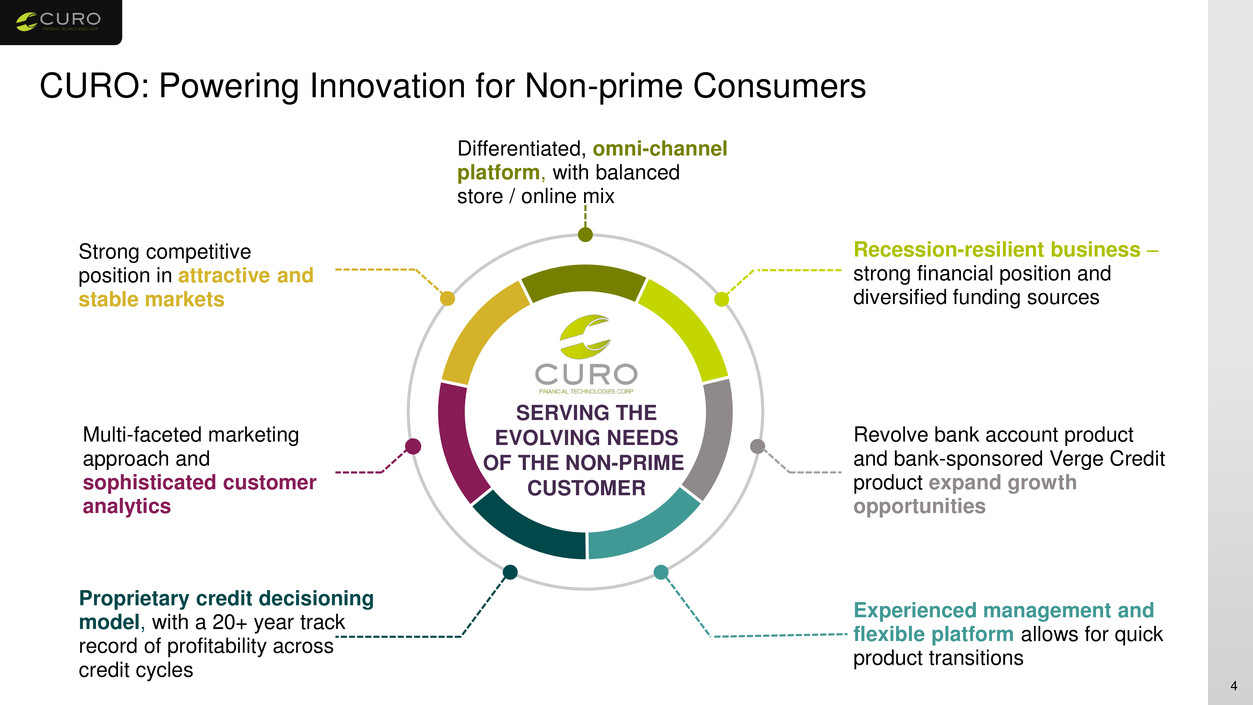
CURO: Powering Innovation for Non-prime Consumers 4 SERVING THE EVOLVING NEEDS OF THE NON-PRIME CUSTOMER Differentiated, omni-channel platform, with balanced store / online mix Recession-resilient business – strong financial position and diversified funding sources Revolve bank account product and bank-sponsored Verge Credit product expand growth opportunities Experienced management and flexible platform allows for quick product transitions Proprietary credit decisioning model, with a 20+ year track record of profitability across credit cycles Multi-faceted marketing approach and sophisticated customer analytics Strong competitive position in attractive and stable markets
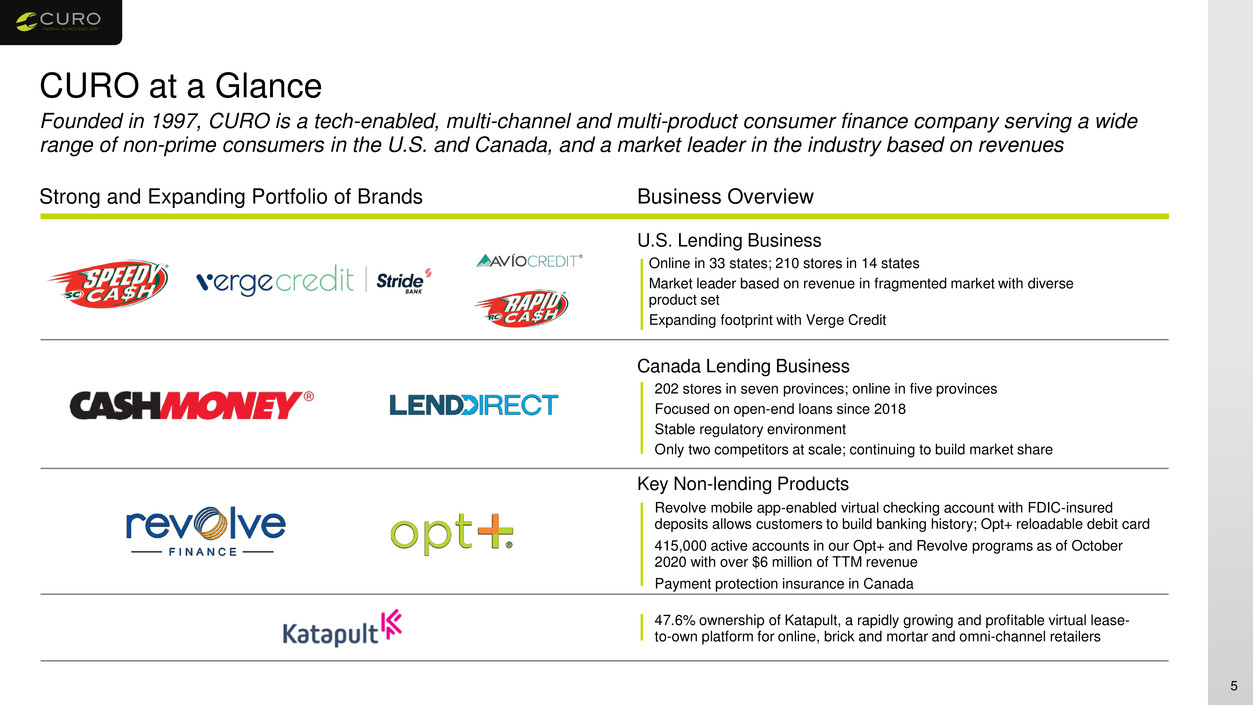
CURO at a Glance 5 Canada Lending Business 202 stores in seven provinces; online in five provinces Focused on open-end loans since 2018 Stable regulatory environment Only two competitors at scale; continuing to build market share U.S. Lending Business Online in 33 states; 210 stores in 14 states Market leader based on revenue in fragmented market with diverse product set Expanding footprint with Verge Credit Key Non-lending Products Revolve mobile app-enabled virtual checking account with FDIC-insured deposits allows customers to build banking history; Opt+ reloadable debit card 415,000 active accounts in our Opt+ and Revolve programs as of October 2020 with over $6 million of TTM revenue Payment protection insurance in Canada 47.6% ownership of Katapult, a rapidly growing and profitable virtual lease- to-own platform for online, brick and mortar and omni-channel retailers Strong and Expanding Portfolio of Brands Business Overview Founded in 1997, CURO is a tech-enabled, multi-channel and multi-product consumer finance company serving a wide range of non-prime consumers in the U.S. and Canada, and a market leader in the industry based on revenues

CURO’s Place in the Alternative Financial Product Market 6 (1) TransUnion’s consumer credit database as of June 30, 2020 (2) Based on TransUnion’s estimated average balances of $4,200 for subprime and $6,800 for near prime consumers (3) Deloitte publication “The DNA of Digital Challenger Banks,” Q3 2020 CURO’s lending businesses participate in large and growing markets; Revolve operates in the challenger-bank space and is focused on customers who already use our lending products $215.4 Million $732.2 Million Over 25,000 Active Accounts TTM Revenue Key Competitors Addressable Market Total installment loan market estimated at ~C$175 billion; a third of Canada’s 30 million active consumers have “below- prime” credit scores (1) US Unsecured personal loan balances in the US of $156 billion result in an estimated addressable market of ~$47 billion (1,2) Challenger banks in U.S. lag other countries, but is rapidly expanding (3) Recent valuations at $500- $1,000 per active account Canada Lending Business U.S. Lending Business
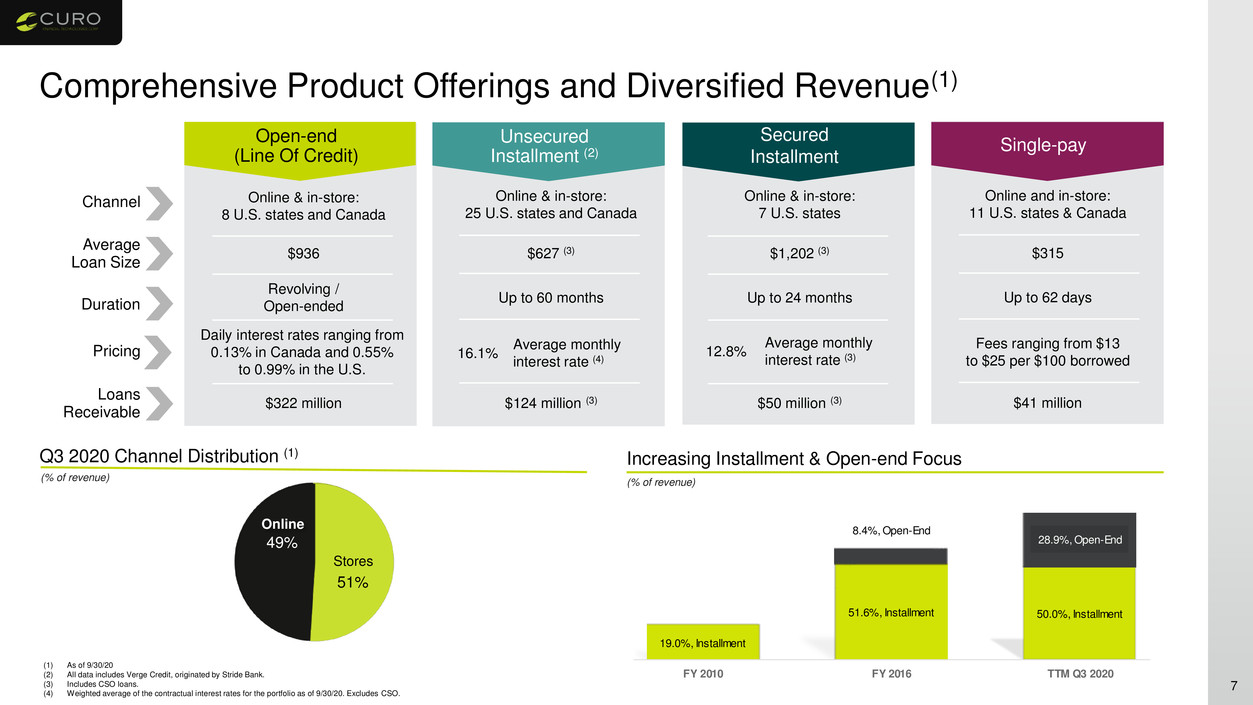
Single-pay Secured Installment Unsecured Installment (2) Open-end (Line Of Credit) Comprehensive Product Offerings and Diversified Revenue(1) 7 (1) As of 9/30/20 (2) All data includes Verge Credit, originated by Stride Bank. (3) Includes CSO loans. (4) Weighted average of the contractual interest rates for the portfolio as of 9/30/20. Excludes CSO. Q3 2020 Channel Distribution (1) (% of revenue) Channel Average Loan Size Duration Pricing Loans Receivable Online & in-store: 8 U.S. states and Canada $936 Revolving / Open-ended Daily interest rates ranging from 0.13% in Canada and 0.55% to 0.99% in the U.S. $322 million Online & in-store: 25 U.S. states and Canada $627 (3) Up to 60 months 16.1% $124 million (3) Average monthly interest rate (4) $1,202 (3) Online & in-store: 7 U.S. states Up to 24 months 12.8% $50 million (3) Average monthly interest rate (3) $315 Online and in-store: 11 U.S. states & Canada Up to 62 days Fees ranging from $13 to $25 per $100 borrowed $41 million 51% 49% Online Stores Increasing Installment & Open-end Focus (% of revenue) i t 19.0%, Installment 51.6%, Installment 50.0%, Installment 8.4%, Open-End 28.9%, Open-End FY 2010 FY 2016 TTM Q3 2020

$ $200 $400 $600 $800 $1,000 $1,200 2003 2004 2005 2006 2007 2008 2009 2010 2011 2012 2013 2014 2015 2016 2017 2018 2019 Drive Channel, Product and Geographic Diversification 8 Annual Revenue ($ millions) Focused Branch Development In U.S. Company founded with first location in Riverside, California Launched analytical brand marketing Expanded into additional states Channel, Product and Geographic Diversification And Development of Omni-channel Platform Began offering installment and open-end loans International expansion to Canada Built leading online and omni-channel platform Further Broad Product Diversification and Brand Development and Market Focus Revision Major open-end loan expansion in Canada Mobile-optimized sites and apps Investment in alternative products including Verge, Revolve and Katapult 2018 – Present1997 – 2007 2008 – 2017

Evolving Geographic and Product Mix 9 Loan Balances $ ($ in millions) Product evolution allows CURO to meet the changing needs and preferences of our customers and adapt to shifts in the regulatory environment Loan Balances % $86.5 $41.3 $201.6 $163.7 $30.5 $56.7 $22.7 $275.5 $- $100.0 $200.0 $300.0 $400.0 $500.0 $600.0 December 31, 2016 September 30, 2020 U.S. Installment U.S. Open-end Single-Pay Canada Open-end 25.3% 7.7% 59.1% 30.5% 8.9% 10.6% 6.6% 51.3% 0% 10% 20% 30% 40% 50% 60% �� 70% 80% 90% 100% December 31, 2016 September 30, 2020 U.S. Installment U.S. Open-end Single-Pay Canada Open-end $341 $537

$35.5 $60.1 291.4 142.8 $399.9 $481.2 $66.9 $146.6 $1.1 $116.8 $- $100 $200 $300 $400 $500 $600 $700 $800 $900 $1,000 2016 Revenue TTM 9/30/20 Revenue Ancillary Single-Pay U.S. Installment U.S. Open-end Canada Open-end Evolving Geographic, Channel and Product Mix 10 Mix has shifted towards Open-End loans and Canada matching customer preference and reducing regulatory risk $795 $947 47.5%52.5% Online Store 30.5% 69.5% Online Store ($ in millions) Product Revenue $ Product Revenue % Revenue Channel as % of Total TTM 9/30/20 TTM 12/31/16 4.5% 6.3% 36.7% 15.1% 50.3% 50.8% 8.4% 15.5% 0.1% 12.3% 0% 10% 20% 30% 40% 50% 60% 70% 80% 90% 100% 2016 Percent of Total TTM 9/30/20 Percent of Total Ancillary Single-Pay U.S. Installment U.S. Open-end Canada Open-end

$0 $50 $100 $150 $200 $250 $300 $350 $400 $450 Open End Single Pay Unsecured Installment Canadian Product Mix Shift Creates Value CURO’s Open-End product is unique in the Canadian market Multi-payment loans regulated at the national level Prescribed APRs result in maximum yield of approximately 47% Optional third-party loan protection insurance product for multi-payment loans (LPP) – Covers up to six months of payments up to $2,000 for job loss or disability – Approximately 64% of customers buy LPP – Customers have benefited particularly during COVID 11 CURO Provides Product Leadership Sustained and Diversified Loan Portfolio Growth Revenue Mix Shift ($ in millions, USD) ($ in millions, CAD) $0 $50 $100 $150 $200 $250 2015 2016 2017 2018 2019 TTM Q3 2020 Open End Single Pay Unsecured Installment Ancillary
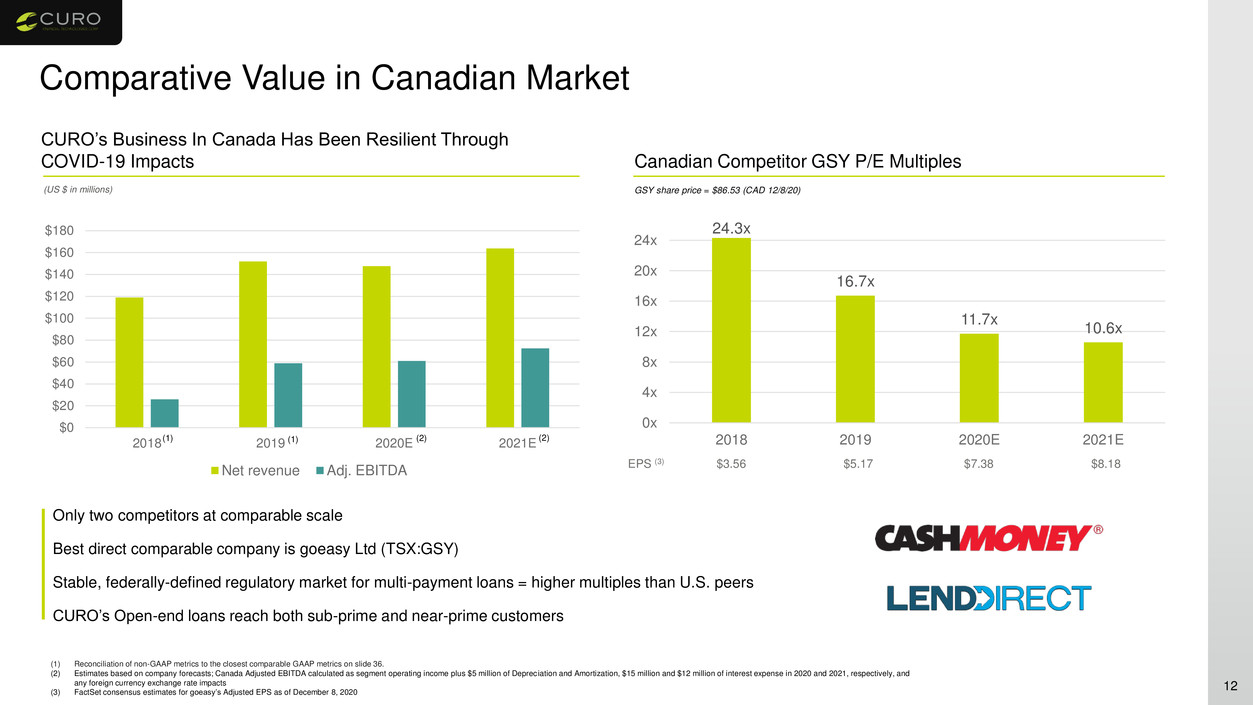
Comparative Value in Canadian Market 12 CURO’s Business In Canada Has Been Resilient Through COVID-19 Impacts (US $ in millions) Only two competitors at comparable scale Best direct comparable company is goeasy Ltd (TSX:GSY) Stable, federally-defined regulatory market for multi-payment loans = higher multiples than U.S. peers CURO’s Open-end loans reach both sub-prime and near-prime customers (1) Reconciliation of non-GAAP metrics to the closest comparable GAAP metrics on slide 36. (2) Estimates based on company forecasts; Canada Adjusted EBITDA calculated as segment operating income plus $5 million of Depreciation and Amortization, $15 million and $12 million of interest expense in 2020 and 2021, respectively, and any foreign currency exchange rate impacts (3) FactSet consensus estimates for goeasy’s Adjusted EPS as of December 8, 2020 $0 $20 $40 $60 $80 $100 $120 $140 $160 $180 2018 2019 2020E 2021E Net revenue Adj. EBITDA GSY share price = $86.53 (CAD 12/8/20) 24.3x 16.7x 11.7x 10.6x 0x 4x 8x 12x 16x 20x 24x 2018 2019 2020E 2021E EPS (3) $3.56 $5.17 $7.38 $8.18 Canadian Competitor GSY P/E Multiples (2) (2)(1)(1)
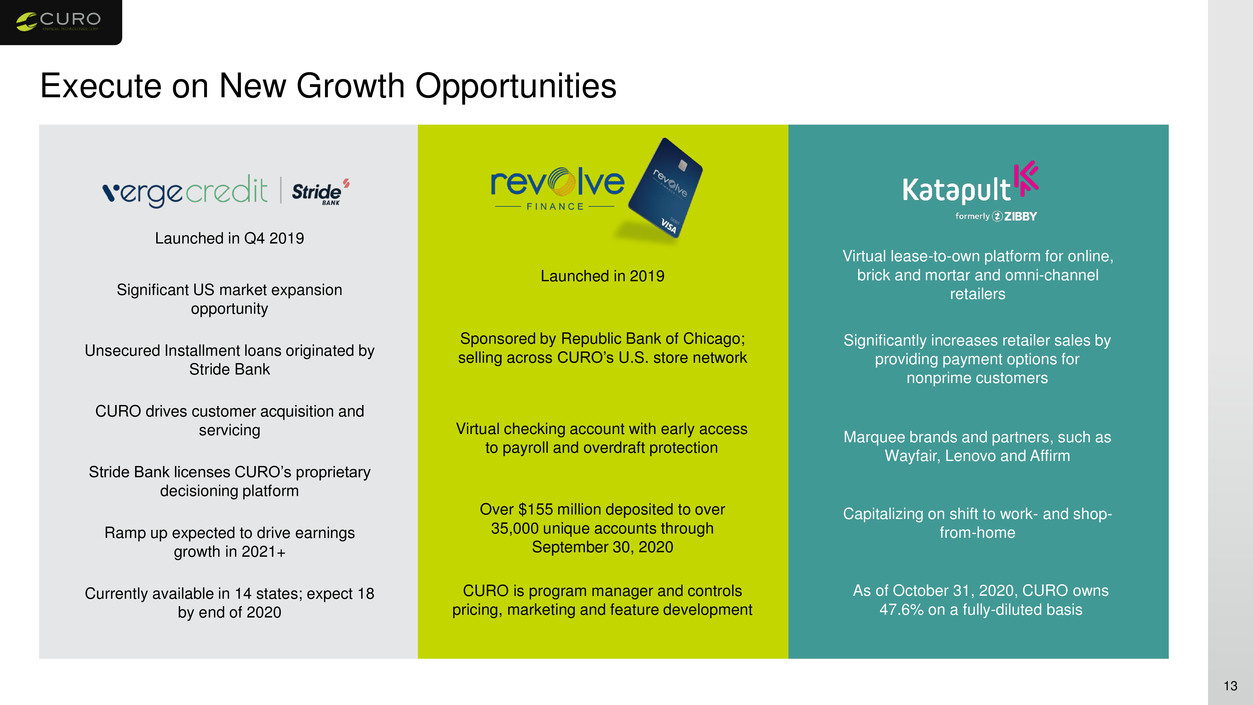
Execute on New Growth Opportunities Launched in Q4 2019 Unsecured Installment loans originated by Stride Bank CURO drives customer acquisition and servicing Stride Bank licenses CURO’s proprietary decisioning platform Significant US market expansion opportunity Ramp up expected to drive earnings growth in 2021+ Currently available in 14 states; expect 18 by end of 2020 Virtual lease-to-own platform for online, brick and mortar and omni-channel retailers Significantly increases retailer sales by providing payment options for nonprime customers Marquee brands and partners, such as Wayfair, Lenovo and Affirm As of October 31, 2020, CURO owns 47.6% on a fully-diluted basis Capitalizing on shift to work- and shop- from-home Launched in 2019 Over $155 million deposited to over 35,000 unique accounts through September 30, 2020 Sponsored by Republic Bank of Chicago; selling across CURO’s U.S. store network Virtual checking account with early access to payroll and overdraft protection CURO is program manager and controls pricing, marketing and feature development 13
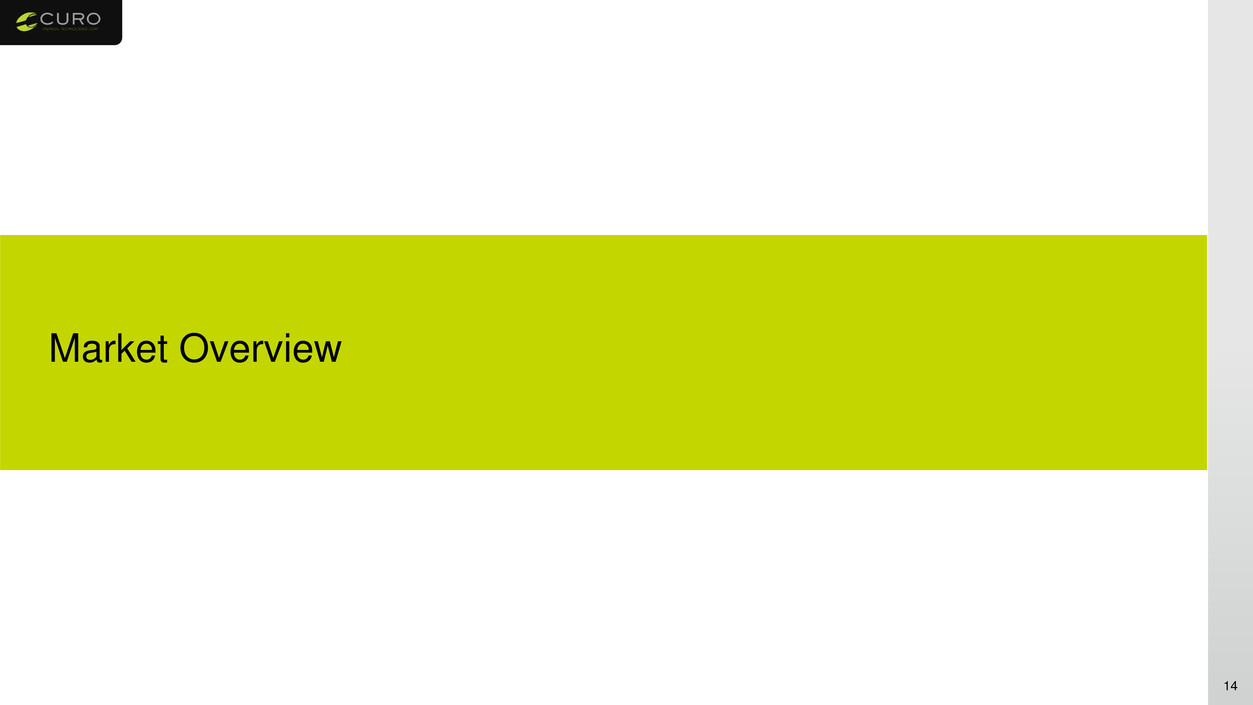
14 Market Overview
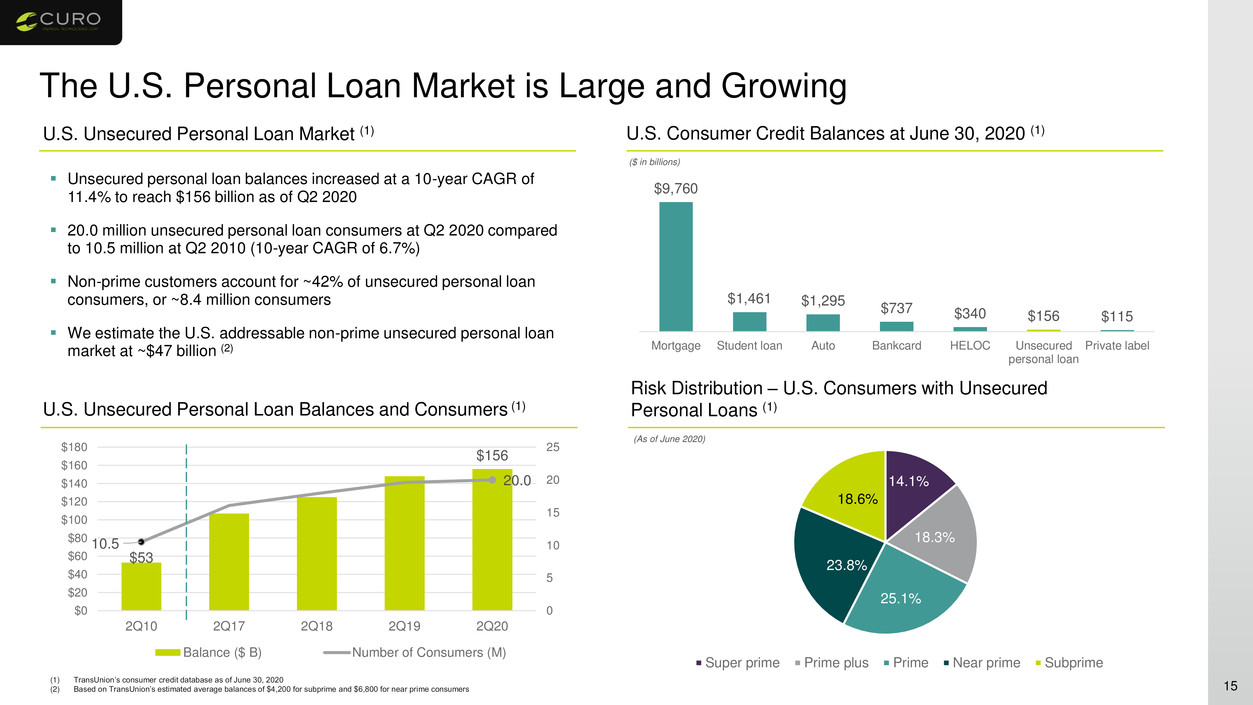
The U.S. Personal Loan Market is Large and Growing (1) TransUnion’s consumer credit database as of June 30, 2020 (2) Based on TransUnion’s estimated average balances of $4,200 for subprime and $6,800 for near prime consumers U.S. Consumer Credit Balances at June 30, 2020 (1) U.S. Unsecured Personal Loan Balances and Consumers (1) U.S. Unsecured Personal Loan Market (1) $9,760 $1,461 $1,295 $737 $340 $156 $115 Mortgage Student loan Auto Bankcard HELOC Unsecured personal loan Private label ($ in billions) $53 $156 10.5 20.0 0 5 10 15 20 25 $0 $20 $40 $60 $80 $100 $120 $140 $160 $180 2Q10 2Q17 2Q18 2Q19 2Q20 Balance ($ B) Number of Consumers (M) Risk Distribution – U.S. Consumers with Unsecured Personal Loans (1) 14.1% 18.3% 25.1% 23.8% 18.6% Super prime Prime plus Prime Near prime Subprime Unsecured personal loan balances increased at a 10-year CAGR of 11.4% to reach $156 billion as of Q2 2020 20.0 million unsecured personal loan consumers at Q2 2020 compared to 10.5 million at Q2 2010 (10-year CAGR of 6.7%) Non-prime customers account for ~42% of unsecured personal loan consumers, or ~8.4 million consumers We estimate the U.S. addressable non-prime unsecured personal loan market at ~$47 billion (2) (As of June 2020) 15
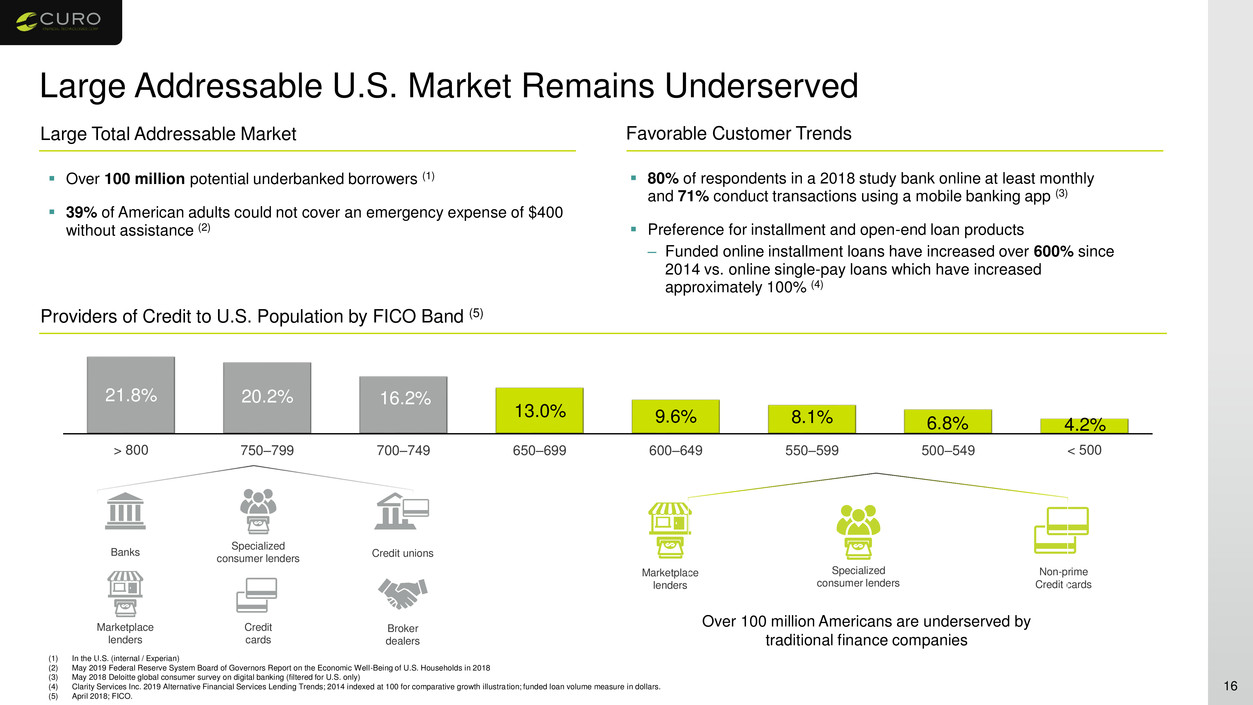
Large Addressable U.S. Market Remains Underserved 16 (1) In the U.S. (internal / Experian) (2) May 2019 Federal Reserve System Board of Governors Report on the Economic Well-Being of U.S. Households in 2018 (3) May 2018 Deloitte global consumer survey on digital banking (filtered for U.S. only) (4) Clarity Services Inc. 2019 Alternative Financial Services Lending Trends; 2014 indexed at 100 for comparative growth illustration; funded loan volume measure in dollars. (5) April 2018; FICO. Favorable Customer TrendsLarge Total Addressable Market Over 100 million potential underbanked borrowers (1) 39% of American adults could not cover an emergency expense of $400 without assistance (2) 80% of respondents in a 2018 study bank online at least monthly and 71% conduct transactions using a mobile banking app (3) Preference for installment and open-end loan products – Funded online installment loans have increased over 600% since 2014 vs. online single-pay loans which have increased approximately 100% (4) Providers of Credit to U.S. Population by FICO Band (5) 21.8% 20.2% 16.2% 13.0% 9.6% 8.1% 6.8% 4.2% > 800 750–799 700–749 650–699 600–649 550–599 500–549 < 500 Over 100 million Americans are underserved by traditional finance companies Specialized consumer lenders Non-prime Credit cards Marketplace lenders Credit unionsBanks Specialized consumer lenders Marketplace lenders Broker dealers Credit cards
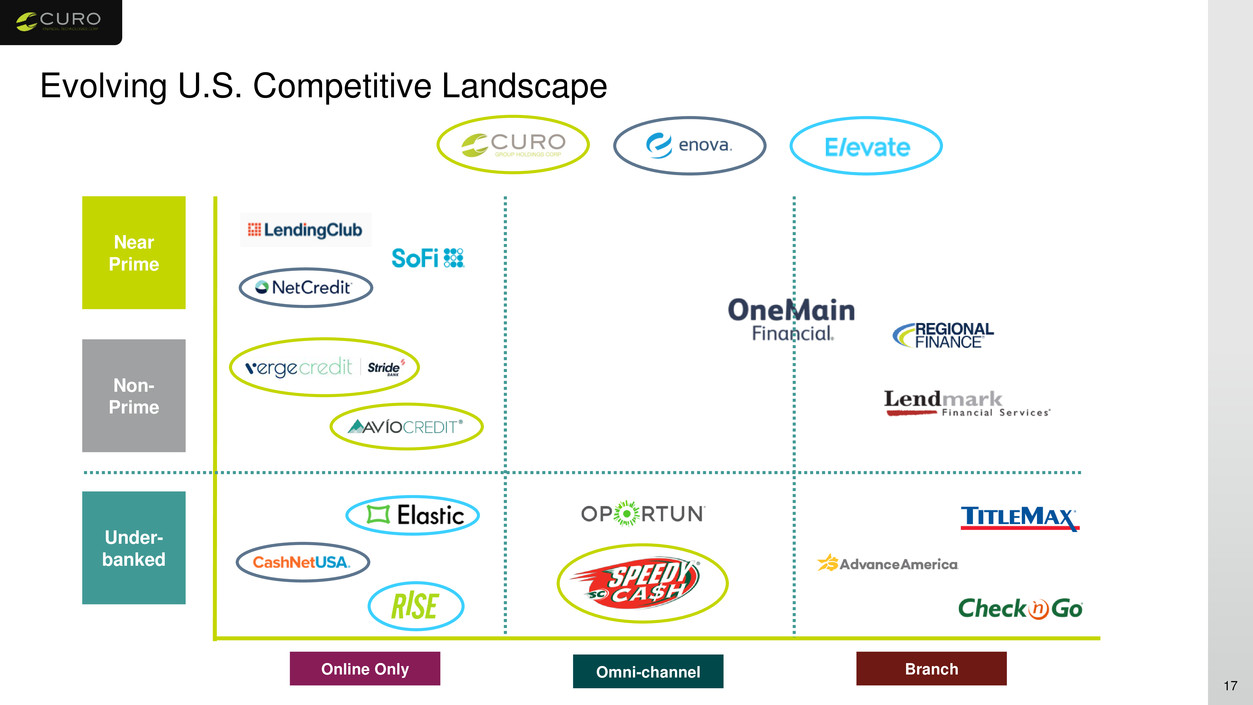
Evolving U.S. Competitive Landscape 17 Online Only Omni-channel Near Prime Non- Prime Under- banked Branch

7% 15% 26% 30% 36% 39%26% 24% 22% 21% 15% 15%30% 27% 23% 22% 22% 20% 37% 34% 29% 27% 27% 26% 2013 2014 2015 2016 2017 2018 FinTech Traditional Finance Company Credit Union Bank FinTech is Taking Share From Banks, Credit Unions and Traditional Finance Companies 18 (1) TransUnion’s consumer credit database as of June 30, 2020 (2) TransUnion’s consumer credit database (3) Company data and SEC filings for Elevate Credit, Enova International, Oportun, and LendingClub Fintech Lending Space Remains Highly Fragmented Credit Unions 21% Banks 27% Traditional Finance Companies 16% FinTechs 36% Total Unsecured Personal Loan Balances of $156 billion at Q2 2020 Public entities 16% Others 84% (3) FinTech Unsecured Personal Loan Balances of $56 billion at Q2 2020 Percentage of Unsecured Personal Loan Balances Originated, Q1-Q3 Each Year (2) U.S. Unsecured Personal Loan Lender Market Share by Total Account Balance (1)
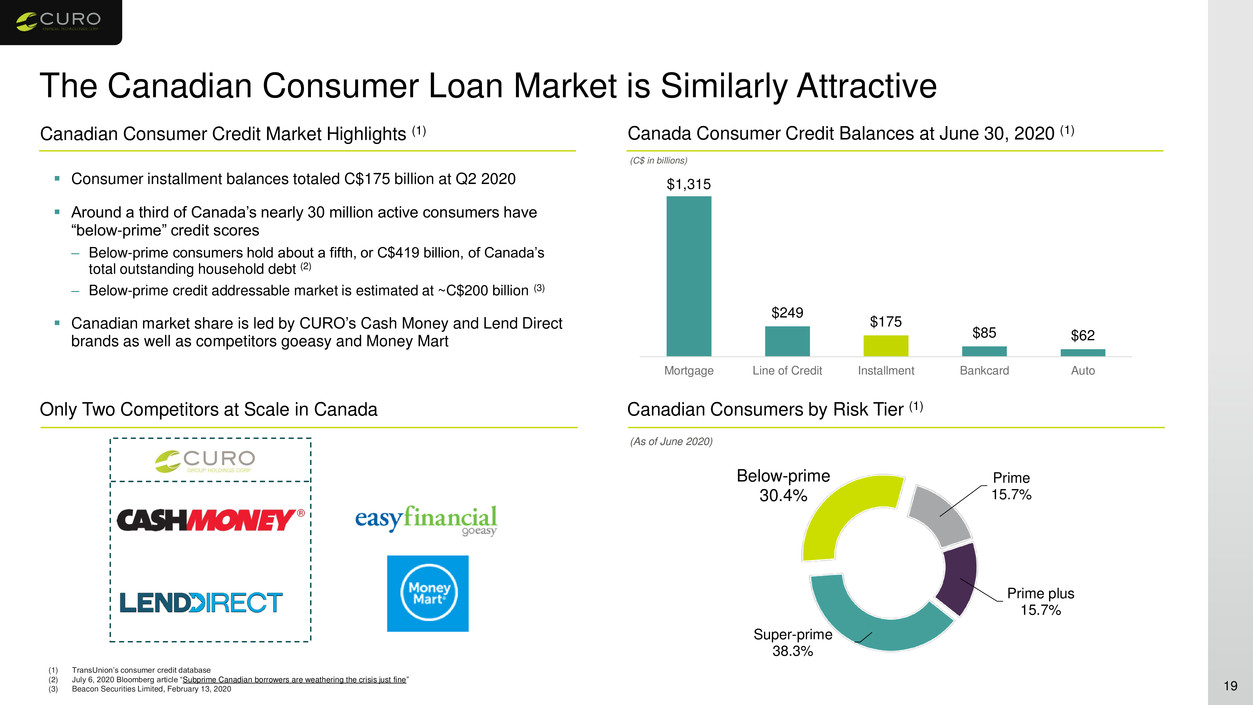
Only Two Competitors at Scale in Canada $1,315 $249 $175 $85 $62 Mortgage Line of Credit Installment Bankcard Auto The Canadian Consumer Loan Market is Similarly Attractive 19 (1) TransUnion’s consumer credit database (2) July 6, 2020 Bloomberg article “Subprime Canadian borrowers are weathering the crisis just fine” (3) Beacon Securities Limited, February 13, 2020 Canada Consumer Credit Balances at June 30, 2020 (1) Canadian Consumer Credit Market Highlights (1) Canadian Consumers by Risk Tier (1) Consumer installment balances totaled C$175 billion at Q2 2020 Around a third of Canada’s nearly 30 million active consumers have “below-prime” credit scores – Below-prime consumers hold about a fifth, or C$419 billion, of Canada’s total outstanding household debt (2) – Below-prime credit addressable market is estimated at ~C$200 billion (3) Canadian market share is led by CURO’s Cash Money and Lend Direct brands as well as competitors goeasy and Money Mart (C$ in billions) (As of June 2020) Below-prime 30.4% Prime 15.7% Prime plus 15.7% Super-prime 38.3%

20 Customer Health
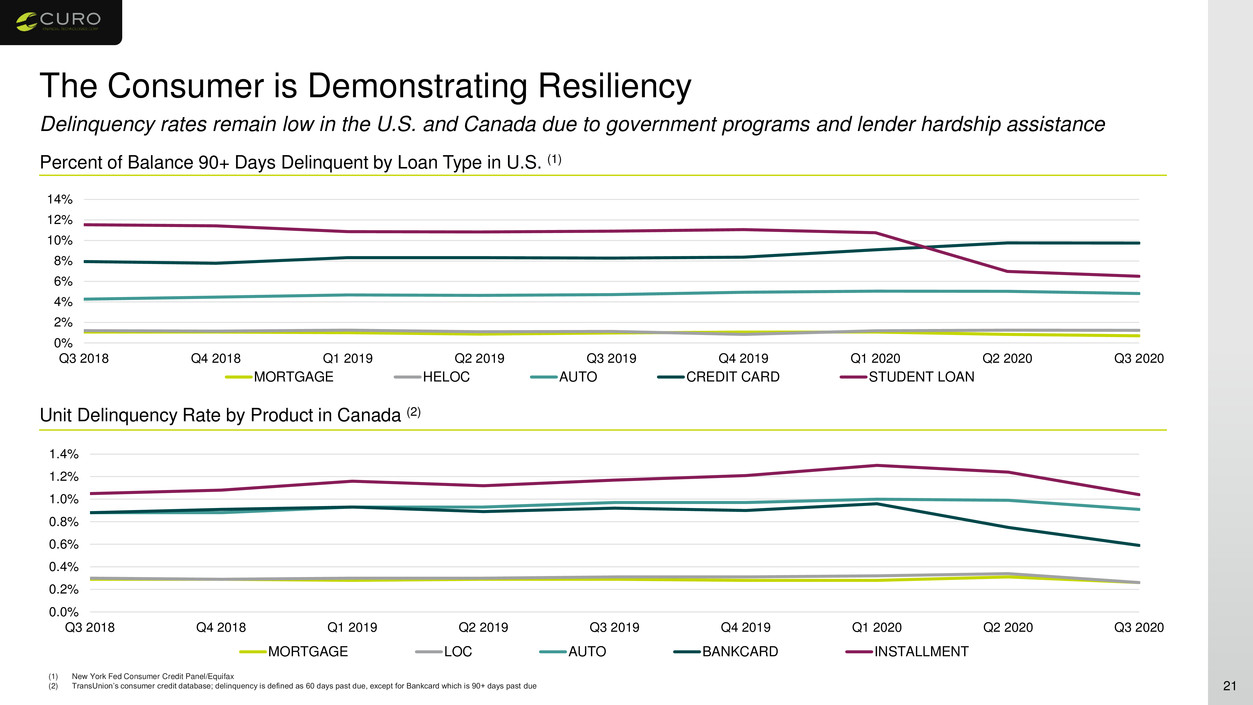
0.0% 0.2% 0.4% 0.6% 0.8% 1.0% 1.2% 1.4% Q3 2018 Q4 2018 Q1 2019 Q2 2019 Q3 2019 Q4 2019 Q1 2020 Q2 2020 Q3 2020 MORTGAGE LOC AUTO BANKCARD INSTALLMENT The Consumer is Demonstrating Resiliency 21 Unit Delinquency Rate by Product in Canada (2) Percent of Balance 90+ Days Delinquent by Loan Type in U.S. (1) (1) New York Fed Consumer Credit Panel/Equifax (2) TransUnion’s consumer credit database; delinquency is defined as 60 days past due, except for Bankcard which is 90+ days past due Delinquency rates remain low in the U.S. and Canada due to government programs and lender hardship assistance 0% 2% 4% 6% 8% 10% 12% 14% Q3 2018 Q4 2018 Q1 2019 Q2 2019 Q3 2019 Q4 2019 Q1 2020 Q2 2020 Q3 2020 MORTGAGE HELOC AUTO CREDIT CARD STUDENT LOAN
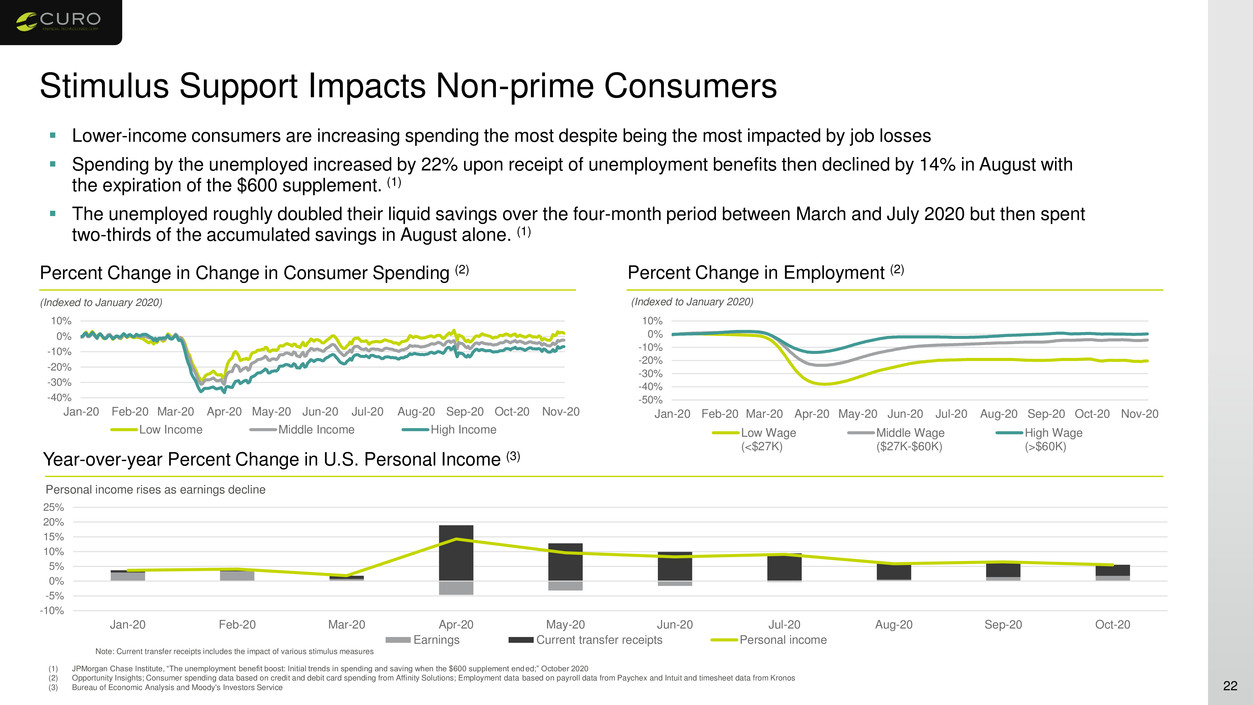
Stimulus Support Impacts Non-prime Consumers Lower-income consumers are increasing spending the most despite being the most impacted by job losses Spending by the unemployed increased by 22% upon receipt of unemployment benefits then declined by 14% in August with the expiration of the $600 supplement. (1) The unemployed roughly doubled their liquid savings over the four-month period between March and July 2020 but then spent two-thirds of the accumulated savings in August alone. (1) 22 (1) JPMorgan Chase Institute, “The unemployment benefit boost: Initial trends in spending and saving when the $600 supplement ended;” October 2020 (2) Opportunity Insights; Consumer spending data based on credit and debit card spending from Affinity Solutions; Employment data based on payroll data from Paychex and Intuit and timesheet data from Kronos (3) Bureau of Economic Analysis and Moody's Investors Service Percent Change in Employment (2)Percent Change in Change in Consumer Spending (2) -40% -30% -20% -10% 0% 10% Jan-20 Feb-20 Mar-20 Apr-20 May-20 Jun-20 Jul-20 Aug-20 Sep-20 Oct-20 Nov-20 Low Income Middle Income High Income (Indexed to January 2020) -50% -40% -30% -20% -10% 0% 10% Jan-20 Feb-20 Mar-20 Apr-20 May-20 Jun-20 Jul-20 Aug-20 Sep-20 Oct-20 Nov-20 Low Wage (<$27K) Middle Wage ($27K-$60K) High Wage (>$60K) (Indexed to January 2020) Year-over-year Percent Change in U.S. Personal Income (3) Personal income rises as earnings decline -10% -5% 0% 5% 10% 15% 20% 25% Jan-20 Feb-20 Mar-20 Apr-20 May-20 Jun-20 Jul-20 Aug-20 Sep-20 Oct-20 Earnings Current transfer receipts Personal income Note: Current transfer receipts includes the impact of various stimulus measures

Subprime Credit Card Limits Cut as Banks Tighten Banks are lowering subprime credit card limits (1) – Limits for subprime borrowers were cut by 19% in 2Q20 compared to an average reduction of 1.2% across all accounts – Subprime limits for store credit cards dropped by 24% in 2Q20 – Subprime utilization rates (outstanding balances compared to available credit) are 16x higher than super-prime customers, so these limit reductions are impactful The Senior Loan Officer Survey shows credit card standards continuing to tighten (2) – A net 27% of banks tightened credit card standards in the October survey down from a recent peak of 72% in the July survey – Credit card charge-offs tend to track changes in credit card standards on a lagged basis 23(1) TransUnion and Bloomberg (2) The Federal Reserve’s Senior Loan Officer Survey and Charge-Off and Delinquency Rates on Loans and Leases at Commercial Banks 0% 2% 4% 6% 8% 10% 12% -40% -20% 0% 20% 40% 60% 80% 1 Q 9 6 1 Q 9 7 1 Q 9 8 1 Q 9 9 1 Q 0 0 �� 1 Q 0 1 1 Q 0 2 1 Q 0 3 1 Q 0 4 1 Q 0 5 1 Q 0 6 1 Q 0 7 1 Q 0 8 1 Q 0 9 1 Q 1 0 1 Q 1 1 1 Q 1 2 1 Q 1 3 1 Q 1 4 1 Q 1 5 1 Q 1 6 1 Q 1 7 1 Q 1 8 1 Q 1 9 1 Q 2 0 % Banks Tightening Standards (4Q forward) Credit card charge-offs (RHS) -25% -20% -15% -10% -5% 0% 5% Subprime Near Prime Prime Prime Plus Super Prime Total Note: Scores based on TransUnion's VantageScore. Subprime = 300-600, near prime = 601-660, prime = 661-720, prime plus = 721-780, super prime = 781-850 Banks are Tightening Credit Card Standards (2)Change in Credit Card Limits During 2Q20 (1)
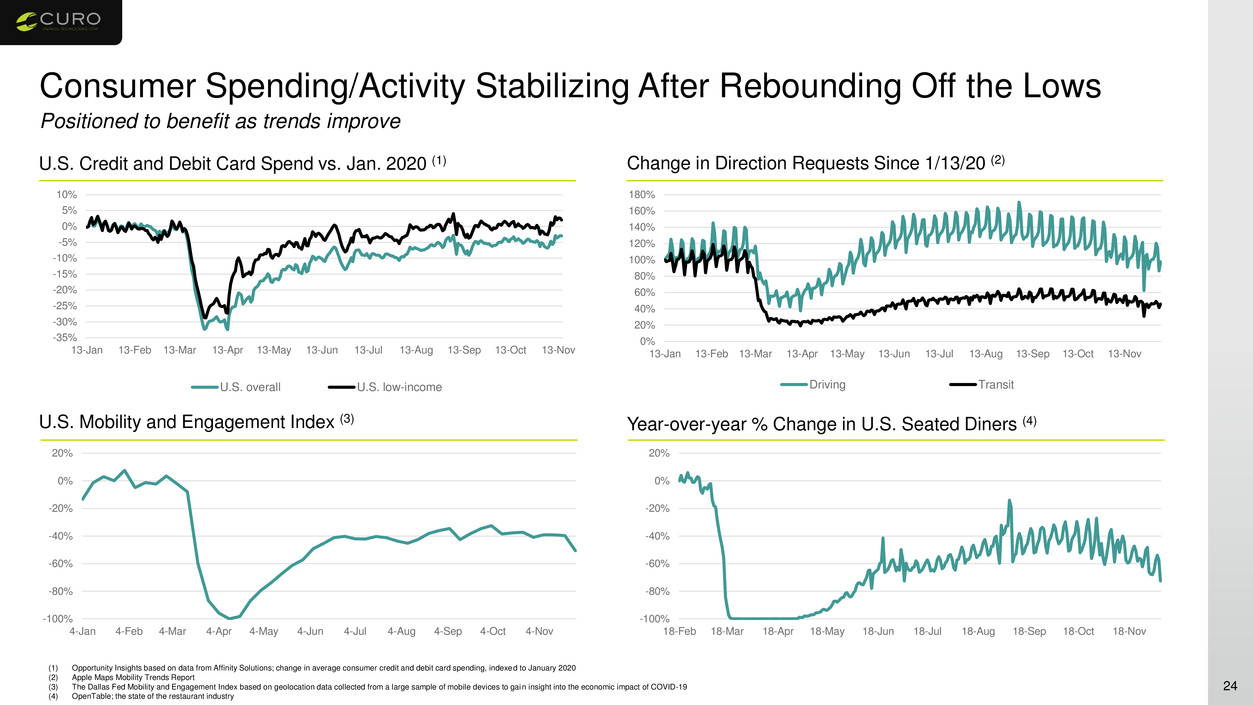
Consumer Spending/Activity Stabilizing After Rebounding Off the Lows 24 (1) Opportunity Insights based on data from Affinity Solutions; change in average consumer credit and debit card spending, indexed to January 2020 (2) Apple Maps Mobility Trends Report (3) The Dallas Fed Mobility and Engagement Index based on geolocation data collected from a large sample of mobile devices to gain insight into the economic impact of COVID-19 (4) OpenTable; the state of the restaurant industry Change in Direction Requests Since 1/13/20 (2) U.S. Mobility and Engagement Index (3) U.S. Credit and Debit Card Spend vs. Jan. 2020 (1) Positioned to benefit as trends improve Year-over-year % Change in U.S. Seated Diners (4) -35% -30% -25% -20% -15% -10% -5% 0% 5% 10% 13-Jan 13-Feb 13-Mar 13-Apr 13-May 13-Jun 13-Jul 13-Aug 13-Sep 13-Oct 13-Nov U.S. overall U.S. low-income 0% 20% 40% 60% 80% 100% 120% 140% 160% 180% 13-Jan 13-Feb 13-Mar 13-Apr 13-May 13-Jun 13-Jul 13-Aug 13-Sep 13-Oct 13-Nov Driving Transit -100% -80% -60% -40% -20% 0% 20% 18-Feb 18-Mar 18-Apr 18-May 18-Jun 18-Jul 18-Aug 18-Sep 18-Oct 18-Nov -100% -80% -60% -40% -20% 0% 20% 4-Jan 4-Feb 4-Mar 4-Apr 4-May 4-Jun 4-Jul 4-Aug 4-Sep 4-Oct 4-Nov
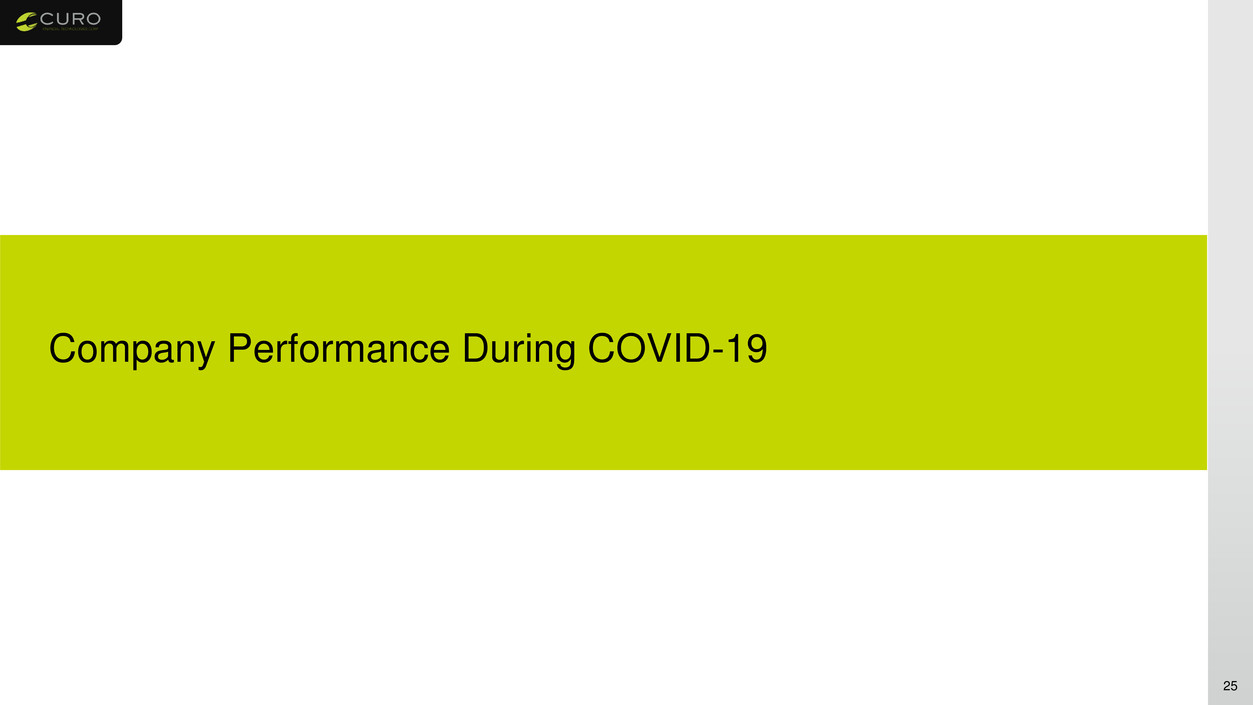
25 Company Performance During COVID-19

Operating Highlights 26 (1) Includes Company-Owned Loans and Loans Guaranteed by the Company under CSO programs. (2) Reconciliation of non-GAAP metrics to the closest comparable GAAP metrics on slides 34 – 35. Customer Trends 2020 Weekly Application Volume Loan Balances (1) Balance Sheet And Credit Financial Performance ($ in millions) 2020 Transaction Mix (week ended) Payment Assistance Provided (loan count) Cash Balances Early-stage Delinquencies Revenue Adjusted EBITDA (2) Adjusted EPS (2) $615 $677 $731 $743 $620 $491 $537 $576 $0 $150 $300 $450 $600 $750 $900 1Q19 2Q19 3Q19 4Q19 1Q20 2Q20 3Q20 Nov-20 $83 $92 $62 $75 $139 $269 $205 $217 $0 $50 $100 $150 $200 $250 $300 1Q19 2Q19 3Q19 4Q19 1Q20 2Q20 3Q20 Nov-20 ($ in millions) $0 $100 $200 $300 1Q19 2Q19 3Q19 4Q19 1Q20 2Q20 3Q20 Revenue Net revenue ($ in millions) $0.80 $0.52 $0.71 $0.80 $0.77 $0.53 $0.27 $0.00 $0.20 $0.40 $0.60 $0.80 $1.00 1Q19 2Q19 3Q19 4Q19 1Q20 2Q20 3Q20 ($ in millions) $73 $54 $67 $68 $66 $51 $36 10% 15% 20% 25% 30% $0 $20 $40 $60 $80 1Q19 2Q19 3Q19 4Q19 1Q20 2Q20 3Q20 Adjusted EBITDA Adjusted EBITDA (%) YoY Change -40% -30% -20% -10% 0% 10% 20% 0% 2% 4% 6% 8% 10% Dec-18 Mar-19 Jun-19 Sep-19 Nov-19 Dec-19 Mar-20 Jun-20 Sep-20 Nov-20 Early Stage Delinquencies YoY Change in Early Stage Delinquencies - 2,000 4,000 6,000 8,000 10,000 U.S. Canada 30% 40% 50% 60% 70% Internet Store 20% 40% 60% 80% 100% 120% 140%
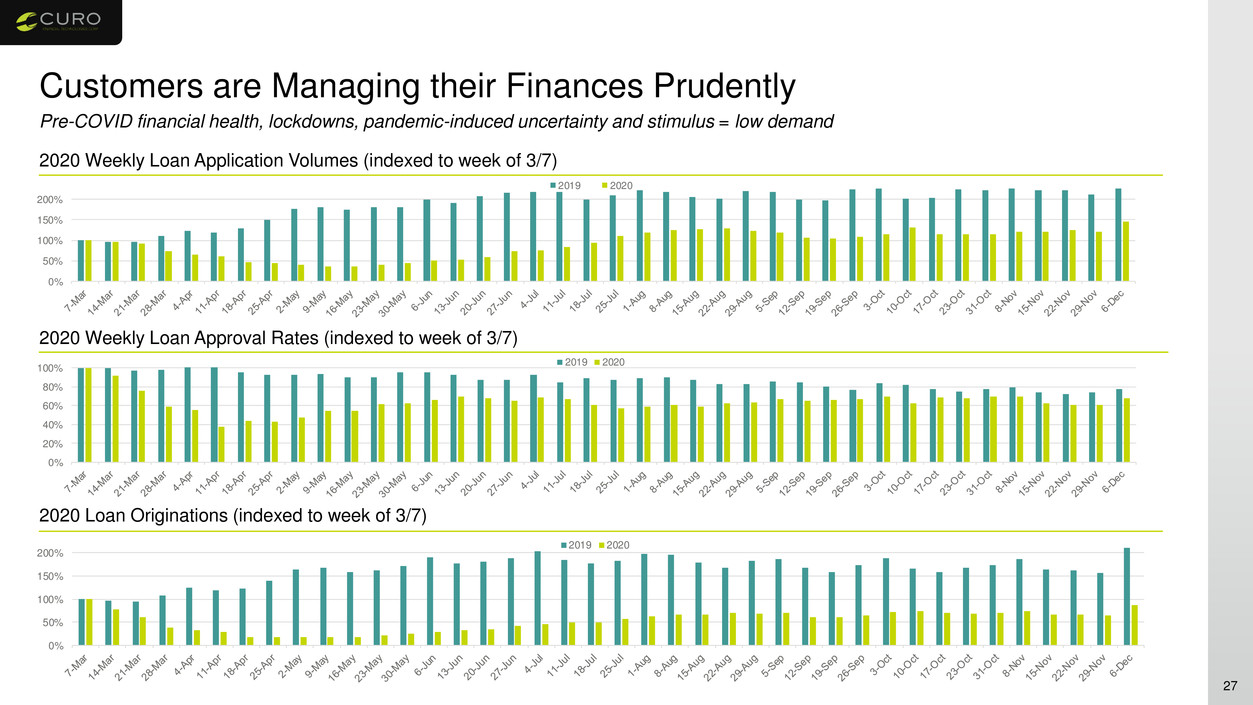
Customers are Managing their Finances Prudently 27 Pre-COVID financial health, lockdowns, pandemic-induced uncertainty and stimulus = low demand 2020 Weekly Loan Application Volumes (indexed to week of 3/7) 2020 Weekly Loan Approval Rates (indexed to week of 3/7) 2020 Loan Originations (indexed to week of 3/7) 0% 50 100% 150 200% 2019 2020 0% 50% 100% 150% 200% 2019 2020 20 40% 60 8 10 2019 2020

Customers are Managing their Finances Prudently (cont’d) YoY Change in Past Due AR Past Due AR % 28 2020 Weekly Delinquent Loans as Percentage of Total (excluding Single Pay loans) -35% -30% -25% -20% -15% -10% -5% 0% 5% 10% 0% 5% 10% 15% 20% 1-30 DPD 31-60 DPD 61+ DPD YOY Change in Past Due

$0 $25 $50 $75 $100 $125 $150 $175 $200 $225 $250 $275 $300 $325 Q1 2019 Q2 2019 Q3 2019 Q4 2019 Q1 2020 Q2 2020 Q3 2020 YTD 2019YTD 2020 Advertising Adjusted NACOPS Adjusted Corporate, district and other Total Core Costs Continuing to Manage Expenses Carefully Lowered operating expenses across several major categories starting mid-March – Reduced advertising and variable compensation costs, froze hiring, suspended merit increases and drove savings from work-from-home initiatives Realized greater than targeted $11 million to $13 million in cost savings in Q2 and Q3 2020 Expense control measures to remain in place until business volume normalizes – Third quarter advertising increase in response to reopening efforts 29 Core Operating Expense Trends (1) ($ in millions) (1) Adjusted Non-Advertising Costs and Adjusted Corporate, district and other excludes Depreciation and Amortization and other expenses excluded in reconciliation Net Income to Adjusted Net Income. Reconciliation of non-GAAP metrics to the closest comparable GAAP metrics included on slide 38.

($ in millions) 2016 2017 2018 2019 Unrestricted cash 182.9$ 153.5$ 61.2$ 75.2$ 138.7$ 269.3 207.1$ 216.8$ Total Liquidity 205.6$ 94.1$ 303.1$ 313.5$ Debt / LTM adjusted EBITDA (1) 3.2x 3.0x 3.7x 3.0x 3.1x 3.2x 3.6x Net Debt / LTM adjusted EBITDA (2) 2.7x 2.5x 3.2x 2.6x 2.8x 2.7x 3.1x December 31, March, 31 2020 11.6% 11.1% 9.1% Nov 30, 2020 LTM adjusted ROAA (1) 11.3% 11.3% 10.9% 13.2% June 30, 2020 Sep 30, 2020 '20 Q4 Q1 Q2 Q3 Q4 Q1 Q2 Q3 Q4 Q1 Q2 Q3 Q4 Q1 Q2 Q3 Q4 Q1 Q2 Q3 Q4 Senior Notes 8.25% U.S. SPV (3) 1-Mo LIBOR + 6.25% (3) Canada SPV 3-Mo CDOR + 6.75% U.S. Revolver 1-Mo LIBOR + 5.00% Canada Revolver Canada Prime Rate +1.95% Interest Rate Counterparties 2021 2022 2023 2024 2025 Strong Debt Capitalization and Liquidity 30 Note: Debt balances are reflected net of deferred interest costs. Subtotals may not sum due to rounding. (1) Reconciliation of non-GAAP metrics to the closest comparable GAAP metrics included within slides 34 – 38. (2) Net Debt excludes U.S. and Canada SPV debt. (3) The Non-Recourse U.S. SPV Facility (“U.S. SPV”) was entered into on April 8, 2020. Concurrent with the closing, we drew $35.2 mi llion on the facility. The Non-Recourse U.S. SPV Facility initially provided for $100.0 million of borrowing capacity and, on July 31, 2020, additional commitments were obtained increasing capacity to $200.0 million. As a result of the increase in commitments, interest now accrues at an annual rate of one-month LIBOR (with a floor of 1.65%) plus 6.25% on balances up to $145.5 million. Balances over that amount accrue interest at an annual rate of one-month LIBOR (with a floor of 1.65%) plus 9.75%. ($ in millions) Well-positioned Funding for Growth Supported by High-Quality Partners Strong Liquidity with Stable LeverageProven Access to Diverse Funding Sources $695 $765 $877 $877 $977 $1,077 $- $200 $400 $600 $800 $1,000 $1,200 12/31/2016 12/31/2017 12/31/2018 12/31/2019 6/30/2020 9/30/2020 Seni r Notes U.S. SPV Commitment (3) Canada SPV Commitment U.S. Rev lver Capacity Canada Revolver Capacity

COVID-19 Customer Care Plan Reinforces our Commitment to Service and Responsible Lending 31 Through October 11, 2020, we have provided substantial financial support to our customers in the form of Payment Waivers, Due Date Changes and Payment Plans on over 77,000 loans or 15% of our active loans Over $5.1 million of Payments Waived on 23k accounts 26k Due Date Changes, and over 10k Payment Plans Cashed stimulus checks worth $67 million free of charge saving customers over $1.1 million Committed $500,000 to Frontline Foods to help feed healthcare workers Waived 240k Returned Item fees saving customers over $5.9 million

Trends to Watch for Remainder of 2020 32 Customer Demand in Canada and U.S. Seasonal demand lift from holiday shopping activity Demand potentially limited by increased COVID shutdowns Competitive Landscape Changes Creating Growth Opportunities Smaller, branch-only competitors are under considerable stress Prime and near-prime lenders have tightened their credit boxes Canadian Open-end Loan Product Continues Growth Trajectory Customer Assistance Requests Remaining Low and Stable with Recent Levels Continued Transaction Mix Shift Toward Online in U.S. and Canada Fourth Quarter Outlook Sequential AR growth >15% (excluding California; >10% total) suggests revenue of $200 million - $205 million NCO rates remain well below normal seasonal levels Investments in strategy and talent result in expected AEBITDA of $29 million - $33 million and AEPS of $0.13 to $0.19 (1) CURO’s share of Katapult’s $8.7 million quarterly net income not included in above metrics (2) (1) Excludes share-based compensation costs, intangible asset amortization and legal and related costs consistent with definitions for comparable items in prior quarters as presented on slides 34-35; assumes approximately 42.4 million fully diluted weighted average shares outstanding for the three months ended December 31, 2020. (2) Katapult’s preliminary income for the three months ended October 2020 is $8.7 million. As of December 9, 2020, CURO owns 47.7% of the total shares of Katapult. However, for the fourth quarter of 2020, CURO expects to record approximately 21% of Katapult’s income as “Income from Equity Method Investment” due to accounting rules regarding treatment of investments in different classes of securities.

33 Appendix

Historical Consolidated Adjusted EBITDA Reconciliation 34 ($Millions) (1) U.K. related costs of $8.8 million for the year ended December 31, 2019 relate to placing the U.K. subsidiaries into administration on February 25, 2019, which included $7.6 million to obtain consent from the holders of the 8.25% Senior Secured Notes to deconsolidate the U.K. Segment and $1.2 million for other costs. (2) The gain from equity method investment for the nine months ended September 30, 2020 of $2.7 million includes our share of the estimated GAAP net loss of Katapult Holdings, Inc. ("Katapul"). We recognize our share of Katapult’s income or loss on a two-month lag using the equity method of accounting with a corresponding adjustment to the carrying value of the investment. For the third quarter of 2020, we recognized 42.5% of Katapult’s income or loss through July 31, 2020. For the year ended December 31, 2019, $6.3 million includes (a) our share of the estimated GAAP net loss of Katapult and (b) a $3.7 million market value adjustment recognized during the second quarter of 2019 as a result of an equity raising round from April through July of 2019 that implied a value per share less than the value per share raised in prior raises. (3) The estimated fair value of share-based awards is recognized as non-cash compensation expense on a straight-line basis over the vesting period. (4) Legal and other costs for the nine months ended September 30, 2020 included (i) settlement costs related to certain legal matters, (ii) estimated costs for certain ongoing legal matters, (iii) costs related to certain securities litigation and related matter, (iv) advisory costs, (v) severance costs for certain corporate employees and (vi) legal and advisory costs related to the purchase of Ad Astra. Legal and other costs for the year ended December 31, 2019 include (i) $1.8 million due to eliminating 121 positions in North America in the first quarter, (ii) costs related to certain securities litigation and related matters of $2.5 million, (iii) legal and advisory costs of $0.3 million related to the repurchase of shares from FFL and (iv) $0.3 million of legal and advisory costs related to the purchase of Ad Astra. (5) The Company received a Notice of Adjustment from Canadian tax authority auditors in the second quarter 2020 related to the treatment of certain expenses in prior years for purposes of calculating the GST due. (6) Other adjustments include the intercompany foreign exchange impact. Q1 2019 Q2 2019 Q3 2019 Q4 2019 Q1 2020 Q2 2020 Q3 2020 Net Income from continuing operations 28.7$ 17.7$ 28.0$ 29.6$ 36.0$ 21.1$ 12.9$ Provision for Income Taxes 10.0 7.5 11.2 9.8 1.9 1.1 (0.8) Interest Expense 17.7 17.0 17.4 17.7 17.3 18.3 18.4 Depreciation and Amortization 4.9 4.7 4.6 4.5 4.6 4.4 4.4 EBITDA 61.3$ 46.8$ 61.2$ 61.5$ 59.8$ 44.9$ 34.8$ U.K. related costs (1) 7.8 0.7 0.3 - - - - Loss (gain) from equity method investment (2) - 3.7 1.4 1.2 1.6 (0.7) (3.5) Share-based compensation (3) 2.2 2.6 2.8 2.7 1.2 3.3 3.4 Legal and related costs (4) 1.8 - 0.9 2.2 3.2 0.9 1.4 Canada GST adjustment (5) - - - - - 2.2 - Other Adjustments (6) (0.2) (0.2) 0.5 (0.1) - 0.6 0.0 Adjusted EBITDA 72.9$ 53.7$ 67.1$ 67.5$ 65.8$ 51.1$ 36.1$ Adjusted EBITDA Margin 26.2% 20.3% 22.6% 22.3% 23.4% 28.0% 19.8%
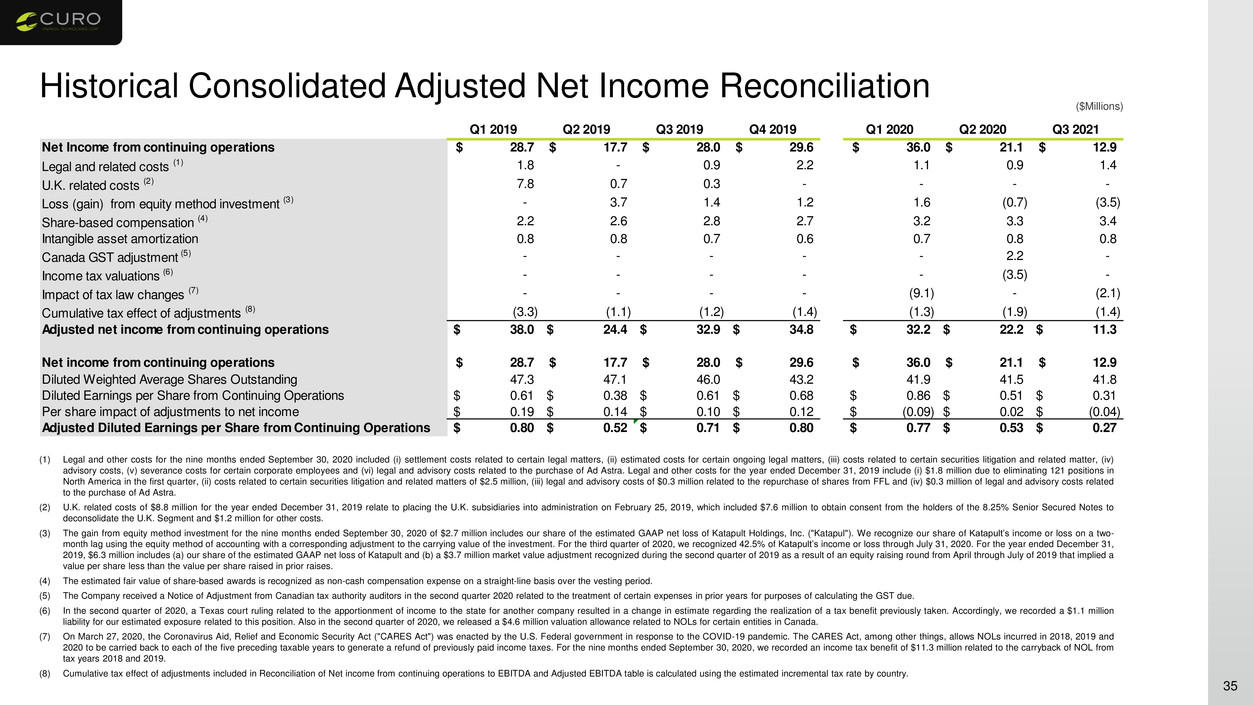
Historical Consolidated Adjusted Net Income Reconciliation 35 ($Millions) (1) Legal and other costs for the nine months ended September 30, 2020 included (i) settlement costs related to certain legal matters, (ii) estimated costs for certain ongoing legal matters, (iii) costs related to certain securities litigation and related matter, (iv) advisory costs, (v) severance costs for certain corporate employees and (vi) legal and advisory costs related to the purchase of Ad Astra. Legal and other costs for the year ended December 31, 2019 include (i) $1.8 million due to eliminating 121 positions in North America in the first quarter, (ii) costs related to certain securities litigation and related matters of $2.5 million, (iii) legal and advisory costs of $0.3 million related to the repurchase of shares from FFL and (iv) $0.3 million of legal and advisory costs related to the purchase of Ad Astra. (2) U.K. related costs of $8.8 million for the year ended December 31, 2019 relate to placing the U.K. subsidiaries into administration on February 25, 2019, which included $7.6 million to obtain consent from the holders of the 8.25% Senior Secured Notes to deconsolidate the U.K. Segment and $1.2 million for other costs. (3) The gain from equity method investment for the nine months ended September 30, 2020 of $2.7 million includes our share of the estimated GAAP net loss of Katapult Holdings, Inc. ("Katapul"). We recognize our share of Katapult’s income or loss on a two- month lag using the equity method of accounting with a corresponding adjustment to the carrying value of the investment. For the third quarter of 2020, we recognized 42.5% of Katapult’s income or loss through July 31, 2020. For the year ended December 31, 2019, $6.3 million includes (a) our share of the estimated GAAP net loss of Katapult and (b) a $3.7 million market value adjustment recognized during the second quarter of 2019 as a result of an equity raising round from April through July of 2019 that implied a value per share less than the value per share raised in prior raises. (4) The estimated fair value of share-based awards is recognized as non-cash compensation expense on a straight-line basis over the vesting period. (5) The Company received a Notice of Adjustment from Canadian tax authority auditors in the second quarter 2020 related to the treatment of certain expenses in prior years for purposes of calculating the GST due. (6) In the second quarter of 2020, a Texas court ruling related to the apportionment of income to the state for another company resulted in a change in estimate regarding the realization of a tax benefit previously taken. Accordingly, we recorded a $1.1 million liability for our estimated exposure related to this position. Also in the second quarter of 2020, we released a $4.6 million valuation allowance related to NOLs for certain entities in Canada. (7) On March 27, 2020, the Coronavirus Aid, Relief and Economic Security Act ("CARES Act") was enacted by the U.S. Federal government in response to the COVID-19 pandemic. The CARES Act, among other things, allows NOLs incurred in 2018, 2019 and 2020 to be carried back to each of the five preceding taxable years to generate a refund of previously paid income taxes. For the nine months ended September 30, 2020, we recorded an income tax benefit of $11.3 million related to the carryback of NOL from tax years 2018 and 2019. (8) Cumulative tax effect of adjustments included in Reconciliation of Net income from continuing operations to EBITDA and Adjusted EBITDA table is calculated using the estimated incremental tax rate by country. Q1 2019 Q2 2019 Q3 2019 Q4 2019 Q1 2020 Q2 2020 Q3 2021 Net Income from continuing operations 28.7$ 17.7$ 28.0$ 29.6$ 36.0$ 21.1$ 12.9$ Legal and related costs (1) 1.8 - 0.9 2.2 1.1 0.9 1.4 U.K. related costs (2) 7.8 0.7 0.3 - - - - Loss (gain) from equity method investment (3) - 3.7 1.4 1.2 1.6 (0.7) (3.5) Share-based compensation (4) 2.2 2.6 2.8 2.7 3.2 3.3 3.4 Intangible asset amortization 0.8 0.8 0.7 0.6 0.7 0.8 0.8 Canada GST adjustment (5) - - - - - 2.2 - Income tax valuations (6) - - - - - (3.5) - Impact of tax law changes (7) - - - - (9.1) - (2.1) Cumulative tax effect of adjustments (8) (3.3) (1.1) (1.2) (1.4) (1.3) (1.9) (1.4) Adjusted net income from continuing operations 38.0$ 24.4$ 32.9$ 34.8$ 32.2$ 22.2$ 11.3$ Net income from continuing operations 28.7$ 17.7$ 28.0$ 29.6$ 36.0$ 21.1$ 12.9$ Diluted Weighted Average Shares Outstanding 47.3 47.1 46.0 43.2 41.9 41.5 41.8 Diluted Earnings per Share from Continuing Operations 0.61$ 0.38$ 0.61$ 0.68$ 0.86$ 0.51$ 0.31$ Per share impact of adjustments to net income 0.19$ 0.14$ 0.10$ 0.12$ (0.09)$ 0.02$ (0.04)$ Adjusted Diluted Earnings per Share from Continuing Operations 0.80$ 0.52$ 0.71$ 0.80$ 0.77$ 0.53$ 0.27$
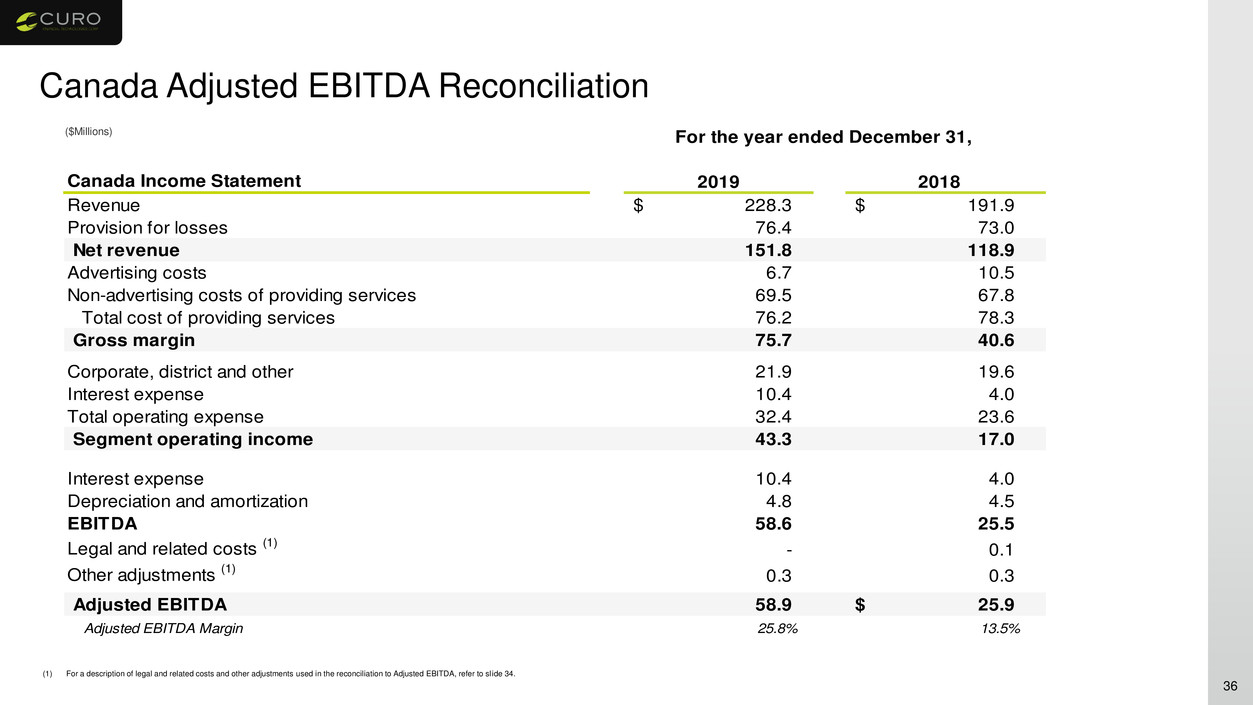
Canada Income Statement Revenue 228.3$ 191.9$ Provision for losses 76.4 73.0 Net revenue 151.8 118.9 Advertising costs 6.7 10.5 Non-advertising costs of providing services 69.5 67.8 Total cost of providing services 76.2 78.3 Gross margin 75.7 40.6 Corporate, district and other 21.9 19.6 Interest expense 10.4 4.0 Total operating expense 32.4 23.6 Segment operating income 43.3 17.0 Interest expense 10.4 4.0 Depreciation and amortization 4.8 4.5 EBITDA 58.6 25.5 Legal and related costs (1) - 0.1 Other adjustments (1) 0.3 0.3 Adjusted EBITDA 58.9 25.9$ Adjusted EBITDA Margin 25.8% 13.5% For the year ended December 31, 2019 2018 Canada Adjusted EBITDA Reconciliation 36 ($Millions) (1) For a description of legal and related costs and other adjustments used in the reconciliation to Adjusted EBITDA, refer to sl ide 34.

Historical Gross Combined Loan Receivables and Adjusted ROAA Reconciliations 37 Note:Subtotals may not sum due to rounding. The above table summarizes Company-owned gross loans receivable, a GAAP balance sheet measure, and reconciles it to gross combined loans receivable, a non-GAAP measure including loans originated by third-party lenders through CSO programs, which are not included in our Condensed Consolidated Financial Statements but from which we earn revenue and for which we provide a guarantee to the lender. (in millions) Dec. 31, 2016 Dec. 31, 2017 Dec. 31, 2018 Dec. 31, 2019 Sep. 30, 2020 Company-owned gross loans receivable $273.2 $413.2 $571.6 $665.8 $497.4 Gross loans receivable guaranteed by the Company 68.0 78.8 80.4 76.7 39.8 Gross combined loans receivable $341.2 $492.0 $652.0 $742.5 $537.2 (in millions) Dec. 31, 2016 Dec. 31, 2017 Dec. 31, 2018 Dec. 31, 2019 Sep. 30, 2020 Total assets $727.4 $802.1 $884.8 $1,081.9 $1,126.5 Average assets 661.7 764.8 843.4 983.3 1,104.2 LTM Adjusted Net Income from Continuing Operations 74.5 86.8 92.3 130.1 100.5 LTM Adjusted ROAA 11.3% 11.3% 10.9% 13.2% 9.1% Period ending
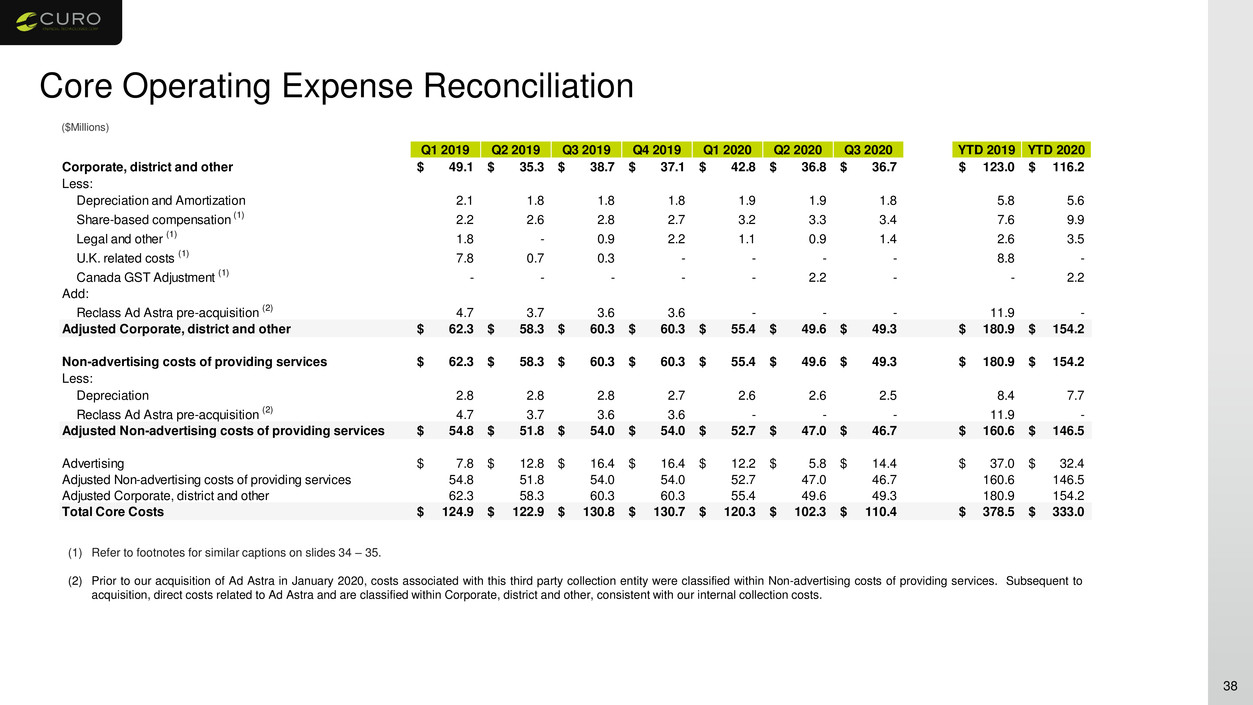
Core Operating Expense Reconciliation 38 (1) Refer to footnotes for similar captions on slides 34 – 35. (2) Prior to our acquisition of Ad Astra in January 2020, costs associated with this third party collection entity were classified within Non-advertising costs of providing services. Subsequent to acquisition, direct costs related to Ad Astra and are classified within Corporate, district and other, consistent with our internal collection costs. ($Millions) Q1 2019 Q2 2019 Q3 2019 Q4 2019 Q1 2020 Q2 2020 Q3 2020 YTD 2019 YTD 2020 Corporate, district and other 49.1$ 35.3$ 38.7$ 37.1$ 42.8$ 36.8$ 36.7$ 123.0$ 116.2$ Less: Depreciation and Amortization 2.1 1.8 1.8 1.8 1.9 1.9 1.8 5.8 5.6 Share-based compensation (1) 2.2 2.6 2.8 2.7 3.2 3.3 3.4 7.6 9.9 Legal and other (1) 1.8 - 0.9 2.2 1.1 0.9 1.4 2.6 3.5 U.K. related costs (1) 7.8 0.7 0.3 - - - - 8.8 - Canada GST Adjustment (1) - - - - - 2.2 - - 2.2 Add: Reclass Ad Astra pre-acquisition (2) 4.7 3.7 3.6 3.6 - - - 11.9 - Adjusted Corporate, district and other 62.3$ 58.3$ 60.3$ 60.3$ 55.4$ 49.6$ 49.3$ 180.9$ 154.2$ Non-advertising costs of providing services 62.3$ 58.3$ 60.3$ 60.3$ 55.4$ 49.6$ 49.3$ 180.9$ 154.2$ Less: Depreciation 2.8 2.8 2.8 2.7 2.6 2.6 2.5 8.4 7.7 Reclass Ad Astra pre-acquisition (2) 4.7 3.7 3.6 3.6 - - - 11.9 - Adjusted Non-advertising costs of providing services 54.8$ 51.8$ 54.0$ 54.0$ 52.7$ 47.0$ 46.7$ 160.6$ 146.5$ Advertising 7.8$ 12.8$ 16.4$ 16.4$ 12.2$ 5.8$ 14.4$ 37.0$ 32.4$ Adjusted Non-advertising costs of providing services 54.8 51.8 54.0 54.0 52.7 47.0 46.7 160.6 146.5 Adjusted Corporate, district and other 62.3 58.3 60.3 60.3 55.4 49.6 49.3 180.9 154.2 Total Core Costs 124.9$ 122.9$ 130.8$ 130.7$ 120.3$ 102.3$ 110.4$ 378.5$ 333.0$





































